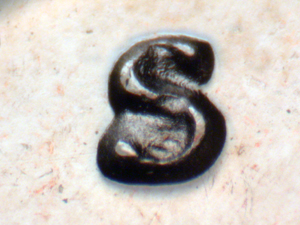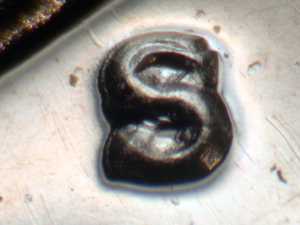
Mintmark Varieties:
Doubled Mintmark Punch: 1974-S
The doubling of the mintmark on 1974-S coinage which appears at first glance to be an repunched mintmark (RPM) is readily discernible. However, upon further investigation this doubled mintmark is believed to be the only known occurrence of a repunched mintmark punch (RPMP).
The “S” Mintmark Styles (MMS)
The S mintmark punch first returned to use in the production of the 1968 proof sets continued in use into 1974. This punch is characterized by rounded serifs and is designated MMS-008 (for the Lincoln Cent). It became defective in 1970, being characterized by a horizontal line in the lower loop and a notch inside the upper curve, but continued to be used into 1974. Sometime around midyear a new S mintmark punch, designated MMS-009 (for the Lincoln Cent) was placed into use. It is characterized by straight serifs and a defect showing up as a bulge or knob on the outside upper curve. The new S mintmark punch of 1974 was used on circulation strikes of that year as well, which included the Lincoln cent and the Ike dollar in 40% silver. This new punch is clearly recognizable into 1977, when it began to show heavy wear. It continued to be used into 1979 (called type 1), when it broke and a new S mintmark punch replaced it creating the type 2 mintmark of that date.
|
|
|
1974-S MMS-008 (type of 1968) |
The new defective S punch of 1974 is known in three stages: (A) perfect, except for the bulge or knob, (B) with a split upper serif only, and (C) with a full doubled upper loop resembling an RPM. All three stages can be found in 1974 with stage B being the scarcest (currently only a Jefferson, Kennedy, and Ike are known). Stage C is known on all denominations of 1974 both in proof and in business strike, being placed in several positions and varying in strength. It is known on three (3) denominations of 1975, including the Lincoln cent, Roosevelt dime and Washington quarter (dual dated 1776-1976). The stage A (perfect) punch is known in 1975, although in a somewhat worn state (now designated as stage D). The stage B (split upper serif only) is not known in 1975 at this time.
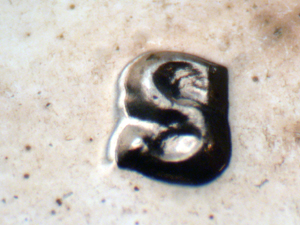 |
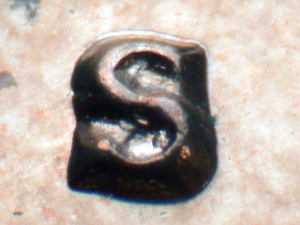 |
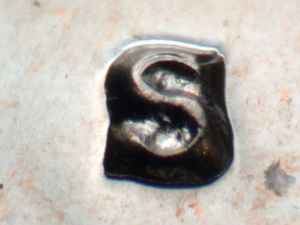 |
| 1974-S MMS-009 (Stage A) | 1974-S MMS-009 (Stage B) | 1974-S MMS-009 (Stage C) |
“RPMs”
From the above listed facts two theories emerge. First is that of a true RPM. Could the person responsible for punching the San Francisco mintmarks produce so many similar RPMs, across all denominations and including business strike and proof coins? It is conceivable, though maybe a little too convenient an answer. Assuming the unexpected demise of the punch that had been in use for 6 years (but was first placed into service in 1952), there would have been a lack of expertise in making a new punch. Remember also that the Mint claims that only one D punch was used throughout the 1970s and this has been confirmed for the Lincoln cent, Jefferson nickel, and Washington Quarter. In fact, it first went into use in 1964. The result of this lack of experience is seen in the new defective punch placed into use. Such circumstances would quite naturally take time and thus create an urgent need for proof dies, especially if the mint was in the middle of its production cycle. With an average proof die life of 3000 coins, 1000 obverse dies per denomination would have been required to meet the proof production in 1974. Similar circumstances arose in the 1960-D Lincoln cent production where the small date was replaced with the large date and consequently, the large date has nearly 100 RPMs. Among these RPMs and those of the following year (1961-D) are many similar in appearance, though clearly distinguishable and in multiple directions. You would have to conclude that the worker who punched the mintmarks in 1974 was consistent even if he wasn't steady handed. It is possible, therefore, to see how the 1974-S RPMs could have occurred. If the replacement took place toward the end of year, then 1975-S and dual dated Bicentennial RPMs would have been made early and as the puncher caught up, the RPMs were eliminated altogether.
However this theory does not fully account for the lack of RPMs (from both mints) in years prior to or after the replacement nor the scarcity of stage B specimens. Why are there only a few RPMs dated 1973 or 1975 from any mint or denomination? Why are there so few dated 1974-D RPMs? Why are the 1974-S RPMs all doubled to the North? Why did they almost all result in a doubled upper loop instead of a split serif? Why are there no lower split serifs? It would seem easier to conclude that the problem was with the new punch and not the puncher.
“RPMPs”
The second theory is that of an RPMP. Picking up with the making of the new punch in the above scenario, all that is necessary here is to see the defective punch as actually a doubled punch. Stage A coins show only the defective bulge or knob. As cold working occurs, stage B (split upper serif only) coins begin to show. Fairly quickly the doubled image bursts out in full color (stage C). As the punch continues to be used across all denominations the doubled image fills in or wears off. The key here seems to be in the fact that no stage B (split upper serif only) coins are known for 1975 or Bicentennial coins, while stage C (full doubling) are known for both 1974 and 1975. The 1974-S doubled mintmarks, while not common, are nonetheless available. It is difficult to find the 1975-S and Bicentennial doubled mintmarks. This tends to indicate that the RPMP began to wear off early in the die production cycle of 1975. Of course this does not mean that true RPMs do not exist for 1974 and 1975. The prime example is the 1975-S Roosevelt Dime RPM-001. There is no mistaking this as a RPMP.
|
|
|
1975-S 10c RPM-001 |
| Home |
Introduction |
Design Changes |
Mintmark Styles |
Doubled Dies |
Mintmark Varieties |
RPDs and MPDs |
Die Errors |
| About CONECA |
About the Author |
Copyright James Wiles, 2011
Email: jameswiles@sbcglobal.net
1490 Trail View Lane
Frisco, TX 75034-2649
